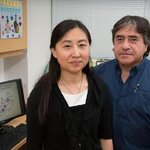Chemistry

Jessica Alba's "Honest" company has been criticized for being frauds but it's not alone. Though the variation in cost for sunscreen protection averages well over 3,000, the variation is protection is not very much.
Like with organic food, you don't get what you pay for - unless what you are paying for is self-identification. But no matter what you pay or why you buy, you may not be getting a product that meets the American Academy of Dermatology's guidelines for sunscreens. This was largely due to a lack of water or sweat resistance, according to a new Northwestern Medicine study.
Though skin…

In the lead up to the World Barista Championships, University of Bath scientists say brewing more flavorsome coffee could be as simple as chilling the beans before grinding.
A team from the University working with renowned Bath coffee shop Colonna&Smalls found that chilling roasted beans before grinding resulted in narrower distribution of small particles, which during the brewing process allows access to more flavor from the same amount of coffee.
Coffee is among the most valuable traded commodities globally, worth $17.9T USD to the US economy in 2015 alone. This discovery could have big…

While Greenpeace is using black hat tactics to take out companies that don't submit to their efforts at racketeering, the pro-science community recognizes that renewable wood could be used to replace oil.
Much of te present-day chemical industry is based on oil; products from plastics to detergents and to medication have their origins in oil and its constituents. Yet oil reserves are finite, so scientists have been looking for ways to manufacture these products from sustainable materials, such as wood.
Proof of concept is in one chemical, succinic acid (see box). A new study demonstrated in a…

Hot molecules, which are found in extreme environments such as the edges of fusion reactors, are much more reactive than those used to understand reaction studies at ambient temperature.
Detailed knowledge of their reactions is relevant for modeling nuclear fusion devices and simulating the reaction that takes place on a spacecraft's heat shield at the moment when it re-enters Earth's atmosphere. In a new in EPJ D paper, Masamitsu Hoshino from Sophia University, Tokyo, and colleagues reveal a method for controlling the likelihood that these reactions between electrons and hot molecules occur…

Thanks to science and technology, food is no longer a luxury, it is a commodity. If anti-science groups spent less time scaring uneducated people and more time caring about humanity, there would be enough food to feed 10 billion people right now, just by reducing food waste.
Right now, almost 50 percent of the world's fruit and vegetable crops are lost, much of it due to perishable foods, according to the Food and Agriculture Organization (FAO) of the United Nations. A new study has one interesting solution - an odorless, biocompatible silk solution so thin as to be virtually invisible that…

This month, the International Agency for Research on Cancer will issue another paper suggesting a chemical causes cancer - probably one of the compounds in coffee - and journalists will read what IARC actually claims about calculating risk and assume IARC calculates risk. Then, after blowback from scientists who do not consult for Environmental Defense Fund or were not hand-picked to be on the IARC committee, IARC will state they don't talk about risk.
There is a difference between hazard and risk, of course. Caffeine is far more hazardous than BPA, glyphosate or aspartame but, like with…

In the world of chemistry, one minus one almost always equals zero.
Almost always? Yes. In 1848, Louis Pasteur showed that molecules that are mirror images of each other had exactly opposite rotations of light. When these "left-handed" and "right-handed" molecules are mixed together in solution, however, they cancel the effects of the other, and no rotation of light is observed. Thus, "one minus one equals zero."
But now our understanding of mirror-image molecules and their optical activity is a little more nuanced.
Northwestern University's Kenneth R. Poeppelmeier and his research team…

Soy isoflavones and peptides may inhibit the growth of microbial pathogens that cause food-borne illnesses, according to a new study from University of Guelph researchers.
Soybean derivatives are already a mainstay in food products, such as cooking oils, cheeses, ice cream, margarine, food spreads, canned foods and baked goods.
The use of soy isoflavones and peptides to reduce microbial contamination could benefit the food industry, which currently uses synthetic additives to protect foods, says engineering professor Suresh Neethirajan, director of the BioNano Laboratory.
U of G researchers…

A range of diseases -- from diabetes to cardiovascular disease, and from Alzheimer's disease to attention deficit hyperactivity disorder -- are linked to changes to genes in the brain, and a new study has found that hundreds of those genes can be damaged by fructose, prevalent in foods like honey.
How did they determine that? Researchers trained rats to escape from a maze, and then randomly divided the animals into three groups. For the next six weeks, one group of rats drank water with an amount of fructose that would be roughly equivalent to a person drinking a liter of soda per day.…

Humans may have the most complex breast milk of all mammals. Milk from a human mother contains more than 200 different sugar molecules, way above the average 30-50 found in, for example, mouse or cow milk.
The role of each of these sugars and why their composition changes during breastfeeding is still a scientific puzzle, but it's likely connected to the infant immune system and developing gut microbiome.
Breast milk is often an infant's first meal, but many of the sugar molecules in the milk are not meant to feed the baby. Infants are born sterile of any bacteria in their guts, but…